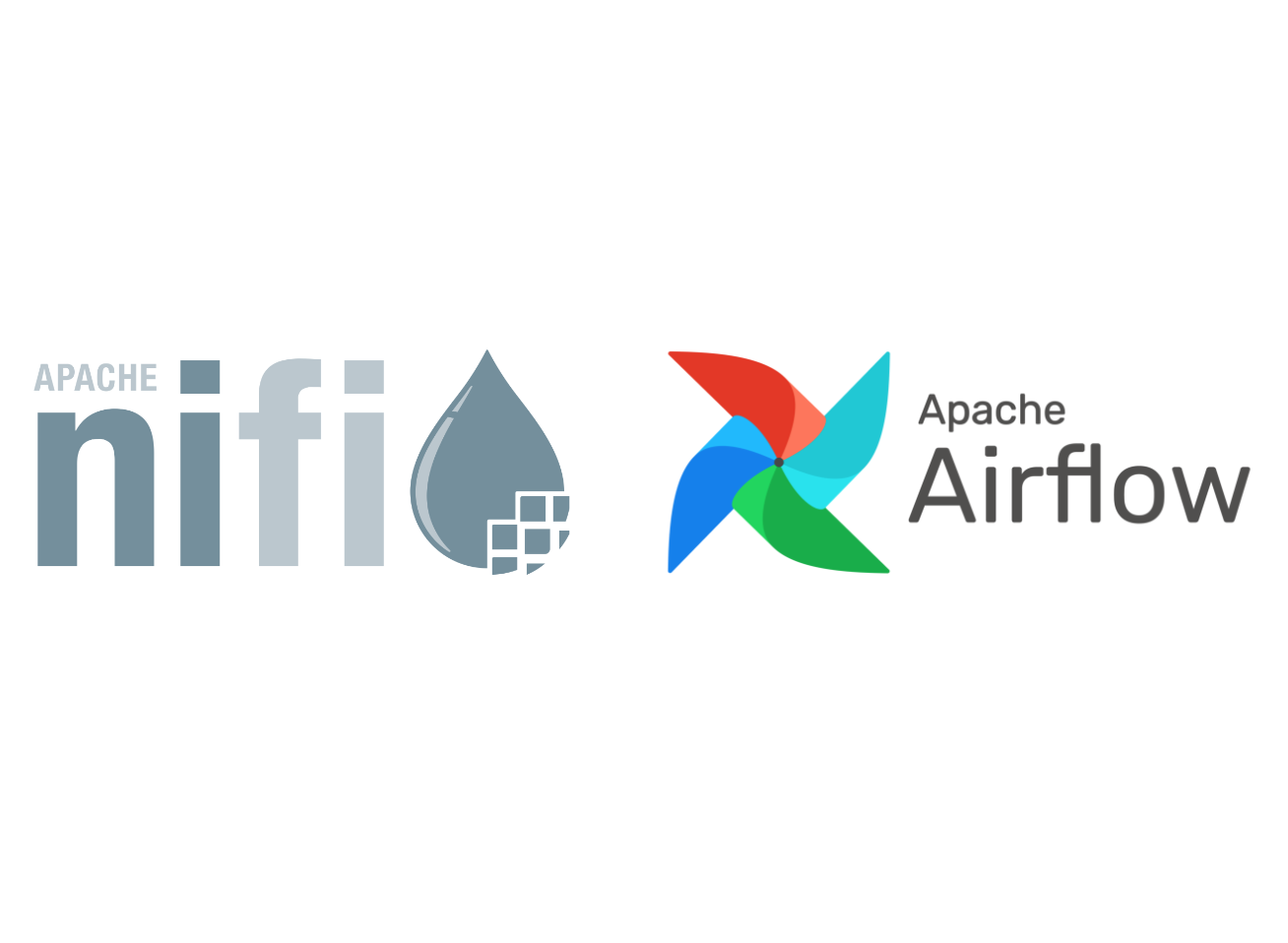Apache NiFi Versus
Apache Airflow
Apache NiFi and Apache Airflow™ are open-source projects that manage data flows. NiFi is a streaming platform for continuous and automated ingestion, transformation, and distribution of multimodal data. NiFi automates cybersecurity, observability, event streams, and generative AI data pipelines. By contrast, Airflow orchestrates complex workflows and manages task dependencies. It focuses on flexibility with Python and is best suited for managing ETL processes and batch processing. Airflow’s setup and configuration are more complex than NiFi’s, and it’s not as efficient for real-time data flows.

Feature Comparisons: NiFi Versus Airflow
The following table compares features between NiFi and Airflow in three areas:
- Managing streaming data pipelines;
- Flexibility and ease of use; and
- Scalability and integration.
Below the table, you’ll find more detail on those differences and why they matter to data engineers, developers, or system administrators.
|
Apache NiFi |
Apache Airflow |
|
| Streaming Data Pipelines | ||
| Data ingestion for streaming pipelines | ✅ | — |
| Back pressure and error handling | ✅ | — |
| Task dependencies and execution order | ✅ | ✅ |
| Flexibility and Ease of Use | ||
| Interactive command and control | ✅ | — |
| Pre-built processors for data manipulation | ✅ | — |
| Deployment and extension of data flows | ✅ | ✅ |
| Defining workflows with directed graphs | ✅ | ✅ |
| Scalability and Integration | ||
| Data traceability and lineage tracking | ✅ | — |
| Custom processors in Java | ✅ | — |
| Custom processors in Python | ✅ | ✅ |
| Clustering for scalability | ✅ | ✅ |
Managing Streaming Data Pipelines
For managing streaming data pipelines, NiFi is better than Airflow for streaming data ingestion and for back pressure and error handling. Airflow has strengths with task dependencies and execution order, but those are not critical for streaming pipelines. When comparing Apache NiFi versus Apache Airflow, teams with large amounts of streaming data should be clear on how quickly and frequently they must add new pipelines and sources.

Data Ingestion for Streaming Data Pipelines
Apache NiFi excels at continuous, large-scale, real-time data ingestion pipelines. Its user-friendly visual interface simplifies the process of building streaming data pipelines to ingest multimodal data from diverse sources. Organizations that need agile ingestion of streaming data should choose NiFi over Airflow.
This is because NiFi was designed for streaming data pipelines. Apache Airflow was not, so it is relatively weak for handling streaming data. Airflow’s paradigm is task-centric. Based on DAGs and Python scripts, it’s better for batch processing and scheduled workflows than for continuous, streaming data ingestion and real-time transformation. Lack of native support for streaming data sources and real-time processing capabilities are two reasons why Airflow is inferior for teams that need streaming data pipelines.
Back Pressure and Error Handling
NiFi’s back pressure capabilities prevent system overload by regulating data flow rates based on processor capacity. When a processor reaches its limit, NiFi automatically adjusts the data flow, preventing bottlenecks and data loss, and optimizing performance. For error handling, NiFi allows for configurable error paths, retries, and detailed logging. These features enable effective identification, isolation, and resolution of issues within a data pipeline.
Apache Airflow lacks built-in back pressure mechanisms, which makes it challenging to manage system overloads with streaming data. It provides basic error handling through retries and task state monitoring, but these pale compared to Apache NiFi’s back pressure management and error handling features.


Task Dependencies and Execution Order
Apache Airflow does have advantages over NiFi for managing task dependencies and execution order. This makes it a good choice for complex workflow orchestration because Airflow’s DAG (Directed Acyclic Graph) model allows users to explicitly define task dependencies and exercise precise control over the order in which tasks are executed. The use of Python further enhances this by providing flexibility and programmability in defining conditional logic and dynamic workflows. Airflow’s rich scheduling features and comprehensive visualization tools help track task execution and dependencies, which is useful for troubleshooting.
While helpful for batch processing and complex workflows, task dependencies and execution order are not well-suited for managing data pipelines with high volumes of streaming data. Airflow’s task-centric model relies on discrete, scheduled tasks that are triggered at specific intervals. The inherent latency in scheduling and task execution can lead to bottlenecks and delays in high-throughput streaming data environments. Also, Airflow’s lack of native support for back pressure management makes it less capable of maintaining performance under the constant influx of streaming data.
Flexibility and Ease of Use: Requirements for an AI Data Pipeline
Apache NiFi is more flexible and easier to use than Apache Airflow. NiFi’s intuitive drag-and-drop user interface simplifies the creation and management of multimodal data flows, making it accessible to users with different levels of technical expertise. With a library of pre-built processors for data manipulation, NiFi streamlines data ingestion, transformation, and routing tasks. NiFi’s capabilities for rapid deployment and seamless modification of data flows helps data engineers create AI data pipelines that keep pace with evolving AI model requirements.
Airflow uses Python-based DAGs (Directed Acyclic Graphs) for workflow definition, requiring users to define and manage workflows programmatically with Python scripts. This code-centric approach is less flexible and harder to use than NiFi’s drag-and-drop interface. However, Apache NiFi version 2.0 also includes the ability to build processors directly in Python.

Interactive Command and Control
Apache NiFi’s visual interface enables interactive command and control. Users intuitively design, configure, and manage data pipelines by dragging and dropping processors onto a canvas and connecting them to define the flow of data. This low-code approach to data flow diagramming makes it accessible to users with varying levels of technical expertise. NiFi’s real-time visual feedback about multimodal data flows enhances everyone’s understanding of the data. Troubleshooting data flows becomes easier, and users can quickly address issues to maintain pipeline reliability.
Apache Airflow takes a very different approach. It defines workflows programmatically using Python code. This can be powerful, but it can be less intuitive and time-consuming, especially for users not proficient in coding. It harms usability and limits flexibility. Airflow’s lack of a visual interface forces users to mentally map multimodal data dependencies. That steep learning curve increases the risk of errors.
Pre-Built Processors for Data Manipulation
NiFi ships with pre-built processors for data manipulation. This offers a distinct usability advantage over Airflow. By providing an extensive library of ready-to-use components tailored for a wide range of data processing tasks, NiFi helps data engineers get up and running easily.
NiFi’s pre-built processors cover data ingestion, transformation, routing, and enrichment. Users can configure data workflows without writing custom code. This plug-and-play approach cuts development time and effort–significantly improving data engineering velocity. Rather than spending time building and debugging custom operators or scripts, data engineers can focus on meeting core data processing needs.

In comparison, Apache Airflow requires users to create custom operators or use Python scripts to transform data. While this might offer flexibility for highly specific requirements, it introduces complexity and increases the chance of errors. Not everyone has the Python skills that Airflow requires.
Apache NiFi’s approach with pre-built processors not only accelerates data flow creation but also ensures that data workflows are reliable and repeatable. This makes NiFi well-suited for scenarios that require rapid deployment and ease of use.

Deployment and Extension of Data Flows
NiFi’s visual paradigm also simplifies the process of deploying and extending data flows. Ten or fifteen years ago, there were fewer, more uniform data flows that data engineers could count on one or two hands. This made ETL worth the effort. No longer.
In today’s world, new multimodal data sources and pipeline opportunities crop up on a weekly basis. With NiFi, data engineers can easily add, remove, or reconfigure processors. They stay ahead of the curve. They respond swiftly to changing data requirements and can troubleshoot issues quickly, without painful redeployment cycles. NiFi’s gift of dynamic data flow modification helps data engineers adapt to evolving business needs.
Airflow’s code-centric approach makes data flows more rigid and time-consuming to modify. For teams looking to move away from the rigidity of ETL jobs–especially for multimodal data–Airflow offers much of the same. Changes to data flows impose code edits and testing that slow data operations.
Data engineers feel the pain acutely, especially when dealing with frequent changes or needing to make quick adjustments. NiFi’s user-friendly interface is a breath of fresh air. Real-time deployment capabilities streamline the entire data flow management process, reducing operational overhead and letting everyone get back to building.
Defining Workflows with Directed Graphs
Both NiFi and Airflow use directed graphs to define data workflows, but they take different approaches for the user interface, data handling, and execution.
Airflow represents directed acyclic graphs (DAGs) in Python code. Nodes (tasks) are connected by edges (dependencies) to define the order of task execution, and users define and orchestrate tasks in a directed graph structure using Python scripts. It executes batch-oriented tasks in a scheduled manner, making it better for batch processing, data pipeline scheduling, and ETL processes. While powerful and flexible for managing those types of workflows, Airflow’s reliance on Python requires coding expertise and limits the range of users. This may be fine for stable environments, but it limits the team’s agility in dynamic data environments.

Scalability and Integration for Unstructured Data Processing
Apache NiFi’s scalability and integration capabilities are crucial for a data flow architecture designed to manage unstructured data processing. NiFi manages multimodal data such as text, images, and audio. Its extensive integration options allow for the seamless ingestion, transformation, and routing of unstructured data from those diverse sources. This ensures that data pipelines remain efficient and adaptable, ultimately enhancing their performance and power for use cases such as training AI models.
Apache Airflow requires far more custom coding than NiFi, and custom code adds risk to the enterprise. In his blog post by the same name, Datavolo’s Field CTO, Sam Lachterman, explains how Datavolo addresses the risk of custom code.
“Datavolo is a platform equipped with a wide range of out-of-the-box processors and patterns for implementing data engineering pipelines for AI use cases. Our aim at Datavolo is to become the trusted partner capable of assuming risks associated with insecure software, low-quality code, and unmaintained code.”
For processing very large amounts of multimodal, unstructured data, Apache NiFi’s data traceability, lineage tracking and horizontal scaling is a better choice for the enterprise. Our Datavolo team has a decade of experience helping data engineers solve complex problems within the Apache NiFi community. Although NiFi includes functionality to create custom processors in both Python and Java, Datavolo provides engineers with over 300 processors for extracting, chunking, transforming, and loading multimodal data for AI use cases, so they can minimize the use of custom code and the technical debt that it causes.
Data Traceability and Lineage Tracking
Apache NiFi puts observability, data traceability and lineage tracking at the core of everything it does. From day one, the data architects at the United States National Security Agency (NSA) designed NiFi with built-in data provenance features to track data lineage, capturing metadata and information about data origin and any in-flight transformations, at every step of its movement throughout the data flow.
This data visibility helps with compliance in highly-regulated industries like financial services or healthcare. NiFi’s data provenance capabilities scale seamlessly with the system, allowing for efficient tracking of flows across distributed clusters and integration with external data governance tools and platforms.

In contrast, Apache Airflow’s traceability and tracking capabilities focus more narrowly on workflow execution and task monitoring. While Airflow provides basic logging and metadata capture for task-level operations, it falls short for unstructured data processing workflows that require granular data traceability and lineage information. Integrating Airflow with external data lineage tools or implementing custom solutions for data tracking can be difficult. Neither of those strategies offers the same level of scalability and integration as NiFi’s native data provenance features.

Custom Processors in Java
NiFi supports the ability to write custom operators–known as processors–in Java. Airflow does not. By allowing developers and data engineers to create custom processors in Java, NiFi lets them handle a wide range of data formats and processing requirements not covered by default processors. Custom processors can be optimized for performance and tailored to efficiently manage large volumes of unstructured data. They can integrate with various external systems and data sources, facilitating seamless data ingestion, transformation, and distribution. NiFi’s extensibility future-proofs it for evolving data landscapes and emerging data streams.
Custom Processors in Python
Apache Airflow’s use of custom processors (operators) in Python supports scalability and integration in unstructured data processing. Airflow’s custom Python operators allow users to extend and customize data processing logic with Python code, for the purpose of handling complex data transformations and integrations with external systems. This lets users create tailored solutions for specific data processing requirements, but with the tradeoff of reducing flexibility to efficiently cover a broader range of data flows.
Apache NiFi 2.0 includes support for custom python processors, adding them to pre-existing functionality to define processors in Java. Support for processors created in both Java and Python opens NiFi to a broader developer base.


Clustering for Scalability
Compared to Airflow’s scaling and integration capabilities, NiFi’s horizontal clustering features enable data processing tasks across multiple nodes for horizontal scalability. Its distributed architecture ensures high availability and fault tolerance, with automatic load balancing to prevent bottlenecks. NiFi’s scalability extends to its seamless integration with external systems and services, thanks to its extensive library of processors and connectors for multimodal data sources, cloud platforms, and APIs. This flexibility for integration enables NiFi to handle unstructured data from known and future data sources.
Apache Airflow’s scaling capabilities are suitable for orchestrating workflows and managing task dependencies, but they struggle to process unstructured data at scale. This is because Airflow’s architecture primarily focuses on workflow scheduling and task execution, with limited built-in support for handling unstructured data sources for real-time data processing. Integrating Airflow with external systems and services often requires custom operators or hooks–adding complexity and potential maintenance overhead.
NiFi’s out-of-the-box scalability and integration features, coupled with its visual interface for data flow design, make it the efficient and effective choice for unstructured data processing.
Still Have Questions About NiFi Versus Airflow? Let’s Talk.
NiFi and Airflow both occupy important places in a data workflow architecture. At Datavolo, we’ve been working with NiFi since its creation.
Schedule some time to talk with us. We’ll discuss your use cases and help you figure out which option is right for you.